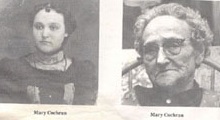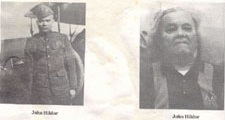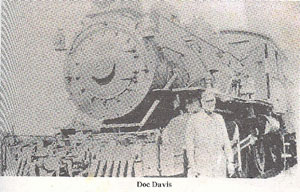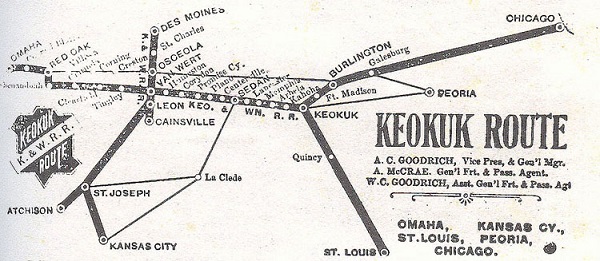

'A CENTURY OF MEMORIES'
1880 - 1980 |
|
Mary E. (Bessie) Cochran - June 1, 1883 |
Mary E. (Bessie) Cochran: Bessie
was born June 1, 1883 on a farm northwest of Woodburn in Clarke County.
She was the youngest of eight children of Mr. and Mrs. Benjamin Lee. She
was in the first graduating class of Woodburn High School, teaching
school the same year that she graduated. Bessie
was born June 1, 1883 on a farm northwest of Woodburn in Clarke County.
She was the youngest of eight children of Mr. and Mrs. Benjamin Lee. She
was in the first graduating class of Woodburn High School, teaching
school the same year that she graduated.She was married to Levi Cochran, November 23, 1902. Six children were born to this union: Leota (Johnson), Clayton, Hope (Paschall), twins Donald (deceased) and Doris (Douthitt), and Betty (Redman). They moved into the Van Wert area in 1936. Levi was engaged in farming and operating a portable mill. Mr. Cochran passed away in October 1972, just one month short of celebrating 70 years of marriage. A highlight of Bessie's golden years was her trip to Hawaii to visit her grandson and a niece at the age of 93 years.  John
Hildor: John
Hildor:John was born in Montgomery County on March 3, 1890, near Red Oak, Iowa. On April 27, 1950, he married Neva L. Krouch of LeRoy. John and Neva have worked at various state hospitals before coming to Van Wert to live in April, 1955. John has farmed and also was a farm worker. Neva has two sisters, Lucille Slagg and Letha Krouch. Alta M. (Holman) DeVore: Alta was born February 10, 1892 near Lorimor, daughter of George and Abigail Holman. On June 11, 1911, she was married to Harrison (Harry) T. DeVore, born September 10, 1889, near Van Wert, the son of William and Sapharona Palmer. Harry and Alta had one son, Gene. Sharon Dale Twombley: Sharon was born in Clarke County, September 14, 1895. He was the son of Ullyses Grant Twombley and Sarah Ellen Watkins, both born in Clarke County. (English descent). His parents were farmers and he had one sister, Gurney. Sharon married Grace South April 18, 1931. They have one daughter, Virginia. Sharon was a farmer and worked as lineman for the Van Wert Telephone Company over 21 years. Willard Manley Wood: Willard was born February 2, 1898 near Weldon in Decatur County. He was the son of William and Mary Wood. Willard married Cecil Lela, daughter of Ed and Ollie Williams, on January 8, 1920 and had lived near Van Wert until a few years ago when they retired from farming and moved to Osceola. Laura "Mildred" (Huffman) Hockmuth: Mildred was born July 20, 1898, daughter of Delbert and Margaret Huffman. She married Samuel Herman Hockmuth. Mr. and Mrs. Hockmuth came to Van Wert where Mr. Hockmuth was the Assembly of God minister at that time. Harriett (Hattie) Boatman: Harriett (Hattie) Boatman was born in 1889. She married Leo Boatman, who was the rural mail carrier for Van Wert for many years. They had two children, Mary and Robert. Mr. Boatman passed away in 1948. Mrs. Boatman moved to Des Moines in the early 1960's where she still lives today. Herman J. Tiedje: Herman Tiedje was born in Gladbrook, Iowa, on February 3, 1893, the son of John and Margaretha Tiedje. Herman married Leila M. Clanton in August, 1915. Leila was born April 4, 1901, the daughter of Frank and Hester Clanton, Herman had two brothers, William and Henry, and one sister, Edith. Leila had one half-sister, Ola, and one half-brother, Bert West. Herman and Leila were parents of four children: Franklin, Alpharetta, Ola Rogene and Mansell. Leila passed away in 1962 in Decatur County. Carl H. "Bob" Upfield: Carl "Bob" Upfield was born June 4, 1899, the son of James C. and Louisa Belle Upfield. Edith Tiedje, daughter of John and Margaretha Tiedje, was born in Gladbrook, Iowa, on October 6, 1919. Carl and Edith were married December 4, 1919. Carl had one sister, Bessie. Edith had three brothers, William, Herman and Henry. Carl and Edith were parents of James, Robert, Barbara, Murry, Betty, Worth and Richard. Edith was born in 1901 and died in 1997. They were farmers until they retired to Osceola. Welcome to 1980 -- New Generation Mr. and Mrs. Duane Otto, a daughter, born January 2, 1980. Name: Miranda Leigh. Mr. and Mrs. Rod Schuldt, a son, born January 2, 1980. Name: Trent Lynn. Mr. and Mrs. Bradley Cullison, a son, born January 10, 1980. Name: Jared Phineas. Mr. and Mrs. Robert Jackson, a son, born February 2, 1980. Name: Jason Lee. Mr. and Mrs. Rick Schuldt, a daughter, born January 29, 1980. Name: Breann Lane. |
| 'RAILROADS' |
| The possibility of railroads and trains was a dream that was on the
verge of coming true. by 1868, no railroads had been built within the
county, but talk and a deep interest was forming for the big Iron Horse
and the promising great advantages it would make to the settlers'
future. In the late 1870's, a stage line was running between Van Wert
and Osceola, making connections with trains going out of there. The
stage was operated by Ab Waggoner. Several projects for bringing rails to Van Wert were being considered. The western part of the county was working on the Iowa and Minnesota Railroad project, later called the Ft. Des Moines and Kansas City Railroad Company. They were confident of the success of the project. Another project was the Chillicothe, Leon and Des Moines Railroad. The Missouri counties to be served by the line, subscribed $50,000 worth of stock toward its construction. About $37,000 was subscribed in Decatur County. I.H. Sales of Leon served as president of the company. Contracts were let for the grading, bridging and tieing for the fifty miles from Chillicothe to Princeton, Missouri, on February 10, 1868, and were ready for the iron by August 1, 1870. The excitement and fascination of the railroads and trains mounted in the 1870's as organizations and companies were being formed to help make the dreams become a reality -- and Van Wert was growing on the hopes of the railroad. The commercial possibilities of the train seemed to be never ending. Passenger travel had very good possibilities in this new frontier. The pioneers needed supplies from the east and they needed freight transportation to market livestock and grains. The farmers had cattle drivers, driving their hogs and cattle great distances to rail centers for shipment to markets. The need for the railroad was certainly there. With some financial problems in 1879 and 1880, the Missouri, Iowa, and Nebraska Railroad extended its road to Van Wert from the east, and then turned this line over to the Humeston and Shenandoah and Western Railroad, which built the line on to Shenandoah. Franklin and Long Creek Townships had voted aid in the form of taxes, with the understanding that the road should be built through the center of the township. However, the road extended along the northern border and townships which had voted the money, opposed the collection of such tax. Franklin won out, while Long Creek paid only enough to cover court costs.  With
the success of the Humeston and Shenandoah and Western Railroad east and
west through Van Wert, it was evident a rail line north and south from
Des Moines, Osceola and Van Wert to Kansas City would be both profitable
and beneficial. With
the success of the Humeston and Shenandoah and Western Railroad east and
west through Van Wert, it was evident a rail line north and south from
Des Moines, Osceola and Van Wert to Kansas City would be both profitable
and beneficial.In this same year (1880), a company was organized in Osceola to build this railroad. The Des Moines, Osceola and Southern Railroad was formed. With the help of subscritions along the way, the road was begun in the spring of 1881 and by 1882, the road was built from Osceola south through Van Wert to Decatur City. It was a "Narrow Gauge" road. There it stopped for some months, the officers of the company apparently undecided which way to go. Decatur Township contributed over $20,000 in tax, besides the subscriptions. The following year, the road turned at a right angle and came to Leon, arriving October 1, 1883. Leon gave $30,000 and also the right of way to the south line of Eden Township. In the spring of 1884, the line was started south again and completed to Cainsville, Missouri. Eden Township gave $6,000 and Hamilton Township, $11,000 and a right of way. Northeast of Van Wert, today the Pete Scadden pasture, the Humeston and Shenandoah and Western Railroad system had built a depot, coal chutes, two Stockyards with two separate sidings, engine house with turn table, water tower with a large lake, just north of complex for needed water for the steam engines and a large ice house for storage of ice for summer refrigeration in special frieght cars, indeed, a rail center with a full compliment of crews and section men as early as 1895. Section crews were needed for track repair as well as bridge repair. A hotel and restaurant were built close by. Taxi and Dray service was readily available to the downtown area. In the early years, the old businesses depended entirely on the railroad, and when the oil business began to create the need, Standard Oil located a bulk plant north of the tracks and west. Shortly after that, Sinclair Oil built their bulk plant just west of the ice house. There were two livestock yards, one located near the depot and the other adjacent to a siding track west of the engine house nearer town. The Des Moines and Kansas City Railroad line, running through the middle of Van Wert, also had a depot located where the Community Building and fire house is today. A siding was just west of the depot that served the grain elevator and stockyards. Van Wert had grown with two hotels and several businesses. On the night of February 13, 1913, this downtown depot burned. The fire was of unknown origin. Because of the large amount of transfer business done in Van Wert, a string of boxcars was used for a depot until railroad officials arranged to have both railroads use the same depot at the northeast part of town. The Des Moines and Kansas City line was up-graded from narrow to standard rails. The new depot was built between the railroad tracks with easy access north and south and more convenience in handling passengers and freight from both lines. At the height of the railroad era in Van Wert, it was " A LITTLE CHICAGO". Four trains in at one time was not unusual. There were twelve trains daily, except Sundays -- eight passengers and four freights. The iron horse took Van Wert people and products to the outside world, and it brought the outside world to Van Wert. On Friday, May 1, 1903, it brought the "President's Train" to Van Wert, and thousands gathered to see and hear President Theodore Roosevelt. Aboard the Governor's train, which arrived fifteen minutes ahead of the "President's Train" was Lt. Governor John Herriott. President Roosevelt and the Lt. Governor both spoke to the crowd, estimated to be between five and ten thousand. The Van Wert Record of that date states that it was probably nearer five thousand, but nearly eighty years later, we would like to think it was probably nearer ten thousand. In the winter of 1936, the train from Van Wert derailed on the crossing on Highway 69. The snow along the highway had been pushed out, and the drifts were at least ten feet high. The V-blade snowplow had made many tries to clear the road. The snow became packed between the rails on the highway crossing, causing the train to derail. Two engines derailed, one turning over and the other tipped. The train was traveling west and the caboose had just crossed the highway. The big drive wheels went in as deep as the axle and froze in the ground. A huge derrick on a steam engine came in to right the train. The crew built a track from the engine back to the regular track and with a series of wedges pulled the engine back a bit at a time. Pupils at Hollingshead School were allowed to go to the track and watch as the train was righted, and it was something they did not forget. The following names were important in our railroad history: 1884-88, S.O. Campbell; 1895-96, E.G. Copeland; 1895-98, F.L. Hall; 1912-16, M.W. Wailes; 1916-23, L.G. Potter; 1897-98, "Adams" telegraph, American Express and Pacific, Alva Tuttle.  Names
of some of the engineers were Doc. Davis and Bill Powers. Bill Finkbone
scooped coal and iced the refrigerator cars, with assistant Hoyle
McConnell. Section crews and foremen were Harry Fisher, Frank Clanton,
Tom Burgan, George Johnson, Bud Fry, Mike Fry, Ralph McBee, Herman
Tiedje, Bill Fry, Ranard and Mel Palmer, Bill Burgan, Bert West and
Harold Stubbs. Bill Snyder was a telegraph line repair man. Names
of some of the engineers were Doc. Davis and Bill Powers. Bill Finkbone
scooped coal and iced the refrigerator cars, with assistant Hoyle
McConnell. Section crews and foremen were Harry Fisher, Frank Clanton,
Tom Burgan, George Johnson, Bud Fry, Mike Fry, Ralph McBee, Herman
Tiedje, Bill Fry, Ranard and Mel Palmer, Bill Burgan, Bert West and
Harold Stubbs. Bill Snyder was a telegraph line repair man.Other familiar names in the "railroad complex" were cattle buyers, Edd Dunaway, Ben Redman, George Redman. Scale men, Dowel Kelly, Albert Simmerman; horse buyers, Henry Schmit and Ray O'Hair. Bill Fuller ran the restaurant west of the depot. Taxi service was provided by Jes Holt, Frank Rush, George Webb and Bill Fuller. The railroad story in Van Wert would not be complete without the mention of the name of Francis Maeberry Fry (1844-1895). He was one of the early pioneers to settle west of Van Wert, and one who played an important part in helping to promote the railroad. Mr. Fry purchased some five hundred acres of land and opened a rock quarry on it, which is still in operation. He furnished rock, sand and limestone for the railroad. Foundation limestone for many buildings in the area came from his quarry as well as for the hospital at Clarinda. One of Francis Fry's sons, William Eureka Fry, began working on the railroad at the age of twelve years, and helped put in the railroad lines. William Fry worked for the railroad lines for a total of fifty-three years. He was one of few who worked for the railroad and lived longer than the railroad itself. The area where Francis Fry settled was called DeKalb and when he passed away in 1895, the railroad company sent a special train to DeKalb to pick up the body and bring relatives and friends who wished to attend the funeral services. It brought them to Van Wert and waited on a siding at the depot until the services were over, and then brought the relatives and friends back to their homes at DeKalb. Pages l0 - l6 |
 |
| Century of Memories Index *** History Index *** Decatur County IAGenWeb |